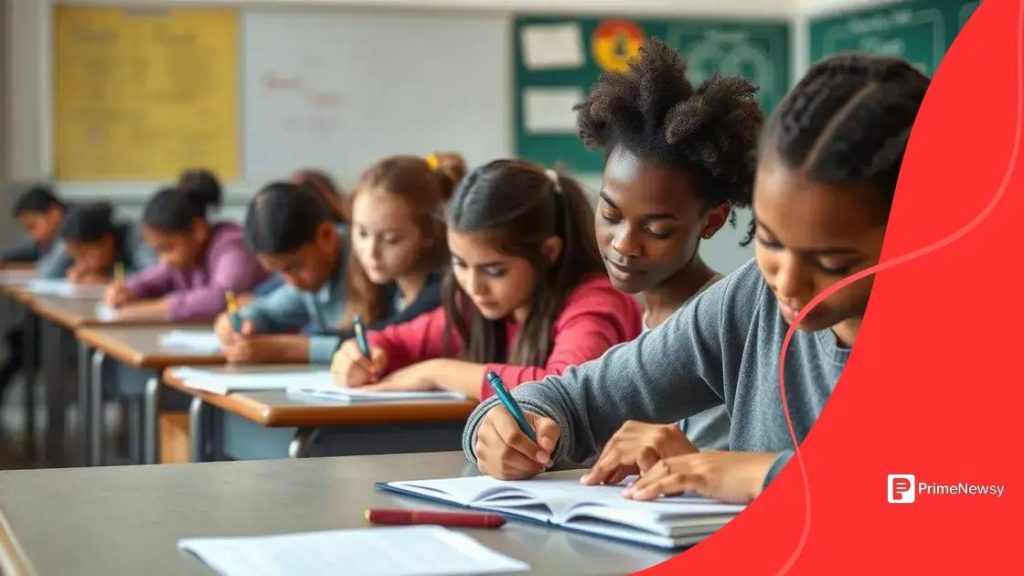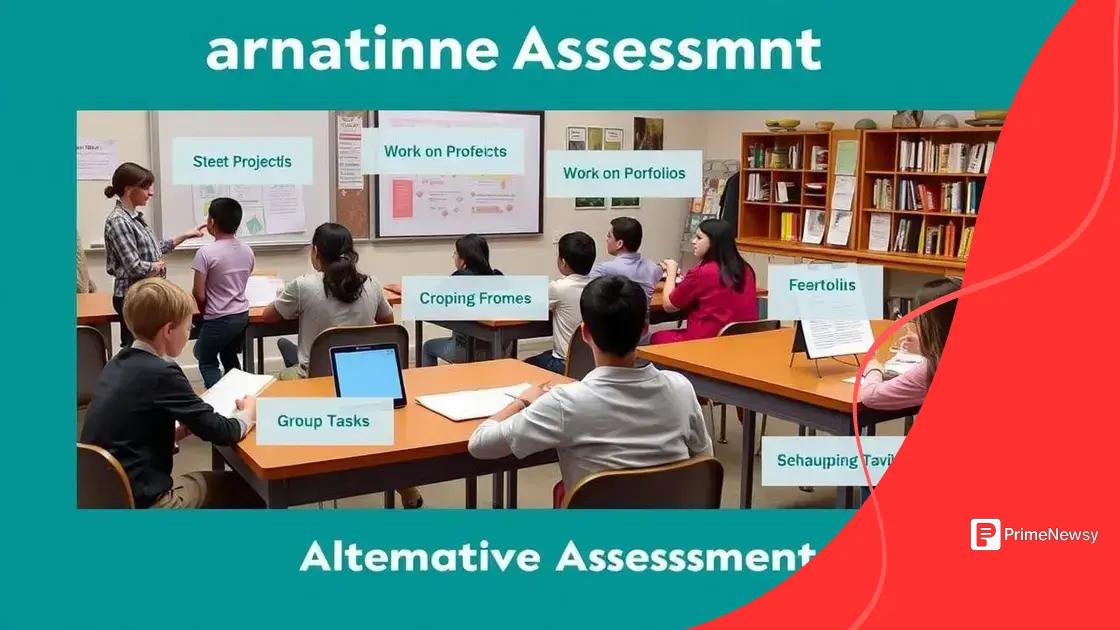Reassessing the reliability of standardized tests

Anúncios
Reassessing the reliability of standardized tests reveals concerns around their fairness, impact on student mental health, and the need for innovative assessment methods that better reflect diverse learning abilities.
Reassessing the reliability of standardized tests raises important questions about their role in education. Are they truly effective measures of student ability, or do they create pressure and inequity? Let’s dive deeper into this topic.
Anúncios
The historical context of standardized tests
Understanding the historical context of standardized tests is crucial to grasp their significance in education. These tests have evolved greatly since their inception, influencing the teaching and learning processes over the decades.
Initially, standardized tests were introduced in the early 20th century. Their primary purpose was to assess students’ abilities and help place them in suitable educational tracks. As educational systems expanded, these tests gained popularity for their perceived objectivity and fairness.
Key Milestones in Standardized Testing
Several significant events have shaped standardized testing:
Anúncios
- The introduction of the IQ test in the 1900s, which aimed to identify gifted students.
- The establishment of the College Board’s SAT in the 1920s, making college admissions more standardized.
- The federal mandates for testing in the 1960s with the push for accountability in education.
These milestones illustrate how standardized tests emerged from academic assessments to pivotal tools in educational policy, influencing curriculum choices and funding decisions.
As we moved into the late 20th and early 21st centuries, debates about the impact of standardized tests intensified. Critics argued that reliance on such tests could lead to teaching to the test, narrowing the curriculum and undermining creativity in the classroom.
Changing Perspectives
Education stakeholders began to question the fairness and reliability of these assessments:
- Are standardized tests truly equitable for all students?
- Do they accurately measure a student’s knowledge and potential?
- What biases might they introduce in diverse classrooms?
These questions prompted a reevaluation of the role standardized testing plays in the educational landscape. As we continue to reassess their reliability, it is essential to consider both historical trends and contemporary challenges. The future of education may depend on our ability to adapt our assessment methods to serve all learners effectively, ensuring that every student has an equal chance to succeed.
Key criticisms of standardized testing
Numerous debates surround the key criticisms of standardized testing. While these assessments aim to measure student learning, many believe they fall short in several areas.
One major concern is how standardized tests may not reflect a student’s true abilities. Critics argue that these tests often favor certain demographics, leading to questions about their fairness. Furthermore, the pressure associated with high-stakes testing can cause significant stress for students.
Common Critiques
Some of the most significant criticisms include:
- Narrow focus: Tests primarily assess a limited range of skills, sidelining creativity and critical thinking.
- Teaching to the test: Educators may feel compelled to focus solely on material that appears on the test, restricting the curriculum.
- Cultural bias: Certain questions may disadvantage students from diverse backgrounds, affecting their performance unfairly.
These critiques highlight significant concerns about the role of standardized tests in education. As the discourse evolves, many educators and policymakers are rethinking how we evaluate student learning.
Another aspect worth noting is the impact of standardized testing on students’ mental health. The anxiety related to high-pressure environments can undermine a student’s performance, leading to an inaccurate portrayal of their capabilities. This situation raises questions about the ethical implications of relying heavily on such assessments.
Alternative Perspectives
Many advocate for alternative forms of assessment that can provide a more comprehensive view of student learning:
- Project-based assessments: Allowing students to demonstrate understanding through real-world applications.
- Portfolio assessments: Showcasing a student’s work over time, highlighting growth and creativity.
- Teacher assessments: Utilizing educators’ insights to evaluate students’ skills and progress.
By exploring these alternatives, educational systems can move towards better evaluation methods that truly reflect a student’s knowledge and potential. The ongoing conversation about the efficacy of standardized testing continues to shape the landscape of education today.
Alternative assessment methods in education

Exploring alternative assessment methods in education opens up new possibilities for evaluating student learning beyond standardized tests. These methods are becoming essential as educators seek more equitable and comprehensive ways to measure student knowledge.
One popular alternative is the use of project-based assessments. Through projects, students can demonstrate their understanding of subjects in practical and creative ways. This approach allows learners to apply their knowledge to real-world situations, fostering deeper engagement.
Types of Alternative Assessments
Several alternative assessment methods can be effectively implemented in classrooms:
- Portfolios: A collection of students’ work over time that showcases their progress, skills, and creativity.
- Performance tasks: Assignments that require students to perform specific tasks, reflecting their ability to apply what they have learned.
- Self-assessments: Students evaluate their own learning, promoting reflection and personal responsibility.
- Peer assessments: Classmates assess each other’s work, providing diverse feedback and perspectives.
Implementing these alternatives encourages a holistic view of student capabilities. For instance, in a portfolio assessment, students might include essays, art projects, and research papers that reflect not only what they know but how they think and create.
Moreover, alternative assessments can alleviate some pressures that come with traditional testing methods. Instead of the anxiety tied to a single exam, students have opportunities to express their understanding in various ways. This flexibility often leads to a more accurate representation of their capabilities.
Benefits of Alternative Assessments
Using alternative assessment methods has numerous advantages:
- Encourages creativity: Students can explore subjects creatively, which might not be possible in traditional tests.
- Individualized learning: Methods cater to diverse learning styles and needs.
- Real-world skills: These assessments often mirror tasks students will encounter outside of school.
By embracing alternative assessment methods, educators can create a more inclusive and engaging environment that truly values each student’s unique learning journey. The future of education may depend on our ability to innovate assessment practices.
Impact on student mental health
The impact on student mental health is a crucial aspect of the conversation surrounding standardized testing. Many students experience significant pressure when facing these assessments, which can lead to high levels of anxiety and stress.
As students prepare for exams, they may feel overwhelmed by the expectations placed on them. This pressure can result in unhealthy coping mechanisms, such as procrastination or excessive studying, which may ultimately hinder their performance.
Effects of Testing Pressure
Several key effects of testing pressure on student mental health include:
- Increased anxiety: Many students report feeling anxious before and during tests, which can negatively impact focus and recall.
- Depression: The continuous cycle of pressure may lead to feelings of hopelessness and sadness in some students.
- Burnout: The constant drive to perform well can lead to exhaustion, making it difficult for students to engage in learning.
- Low self-esteem: Poor test performance can result in negative self-perception and a belief that they are not capable learners.
The mental health outcomes associated with standardized testing highlight the need for more supportive educational environments. Many students have valuable skills that may not be accurately represented by test scores, so it is essential to foster a system that acknowledges diverse strengths.
In addition, supportive measures such as counseling and stress-relief workshops can help students cope with the pressures of standardized tests. Educators and parents can play a vital role in creating a balanced approach to testing that considers mental well-being.
Strategies for Coping
Students can also adopt various strategies to cope with testing anxiety:
- Mindfulness techniques: Practices like deep breathing or meditation can help reduce stress levels.
- Time management: Developing a study schedule that allows for adequate preparation can help ease anxiety.
- Seeking support: Talking to teachers or friends about feelings regarding testing can provide comfort and understanding.
By addressing the impact on student mental health, schools can promote healthier assessment practices. Ensuring that students have access to mental health resources will support their overall well-being as they navigate their educational journey.
Future directions for standardized tests
Exploring the future directions for standardized tests highlights the evolving nature of education and assessment. As we move forward, it is essential to reassess how these tests can adapt to meet the needs of our students better.
One major shift involves incorporating technology into standardized testing. Digital assessments can provide immediate feedback and a more interactive experience. This approach may reduce some anxiety, as students are familiar with technology and find it engaging.
Potential Innovations
Several innovations are on the horizon for standardized testing:
- Adaptive testing: These tests adjust their difficulty based on the student’s responses, allowing for a more personalized assessment.
- Performance-based assessments: Evaluating work through projects or presentations rather than traditional formats may better reflect a student’s skills.
- Broader subject areas: Testing could expand to include social-emotional learning competencies and critical thinking, acknowledging skills beyond academic knowledge.
These innovations aim to create a more comprehensive understanding of student abilities and learning styles. By focusing on skills relevant to the 21st century, education can equip students effectively for future challenges.
Another direction is the growing emphasis on equity in assessment. As educators and policymakers recognize the disparities in current testing methods, changes may be made to provide fairer evaluations for all students. This could include reducing cultural biases and providing accommodations for diverse learners.
Collaborative Approaches
The future of standardized tests may also involve collaboration among various educational stakeholders:
- Teachers: Input from educators can ensure that assessments align with classroom instruction and reflect student learning.
- Parents: Engaging families in discussions about testing can offer valuable insights into student needs and stressors.
- Students: Including student voices in the assessment process can lead to more meaningful evaluations.
By collaborating, educational systems can work towards assessments that truly serve their students and foster a positive learning environment. The journey toward reimagining standardized tests is ongoing, but it holds promise for creating fairer and more effective evaluation methods.
In conclusion, the discussion surrounding standardized testing is complex and multifaceted. As we examine the reliability of these tests, it becomes clear that they are not the only means of assessing student learning. Emphasizing alternative methods and focusing on mental health can lead to more equitable education. Additionally, as we look towards the future, innovations in testing and collaboration among stakeholders will play a crucial role in shaping assessments that cater to diverse learning needs. It’s time to rethink our approach to testing and create a supportive environment that encourages student growth and success.
FAQ – Frequently Asked Questions about Standardized Testing
What are the main concerns regarding standardized tests?
Main concerns include their reliability, potential biases, and the stress they place on students.
How can alternative assessment methods benefit students?
Alternative methods, such as project-based assessments, can provide a more comprehensive view of a student’s abilities and foster creativity.
What impact do standardized tests have on student mental health?
Standardized tests can contribute to anxiety and stress, affecting students’ performance and overall well-being.
What innovations are being considered for the future of standardized testing?
Innovations include adaptive testing, technology integration, and efforts to ensure fairness and inclusivity in assessments.